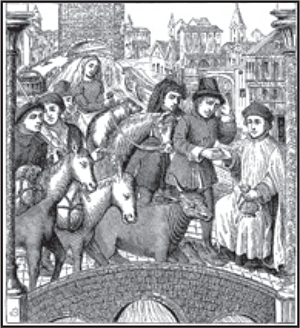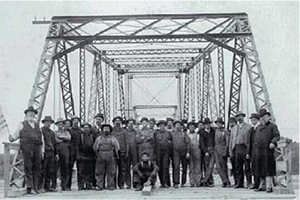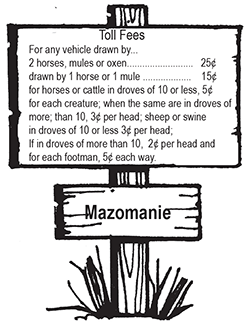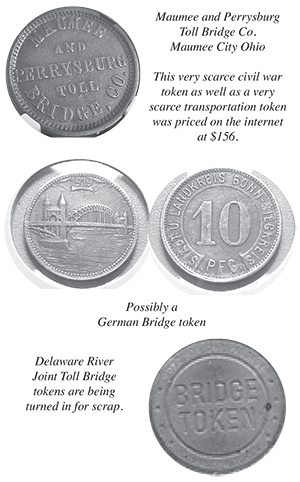
NOW Articles Written By Members
Bullion And Coin Tax Exemption – Act Now!
Is There A Twenty Cent Piece We Can Add To A Collection
Capped Bust Half Dollars: A Numismatic Legacy
U.S. Innovation Dollars: Our Most Under-Collected Coin?
My 2023 ANA Summer Seminar Adventure
In defense of the American Women's Quarters
A look back in numismatic history – the Hicksville Silver Dollar Hoard
The proofs so few of us collect: Jefferson Nickels
A look back in numismatic history – a story too good to be true
Kilroy promotes war bond sales
Just passing through a short-lived bank
The Kewaunee Line Encased Coin Folder
Lyman C. Draper: Collector, Historian, Genealogist
>> More articles in the Archive
For more NOW Articles Written By Members,
<< More articles in the Archive
Toll Bridges a Part of the Past
[Ron Calkins #34L]
 The practice of collecting tolls on bridges probably harks back to the days of ferry crossings where people paid a fee to be ferried across stretches of water. As boats became impractical to carry large loads, ferry operators looked for new sources of revenue. Having built a bridge, they hoped to recoup their investment by charging tolls for people, animals, vehicles and goods to cross it.
The practice of collecting tolls on bridges probably harks back to the days of ferry crossings where people paid a fee to be ferried across stretches of water. As boats became impractical to carry large loads, ferry operators looked for new sources of revenue. Having built a bridge, they hoped to recoup their investment by charging tolls for people, animals, vehicles and goods to cross it.
Wisconsin Toll Bridges
Hudson Toll Bridge
The Hudson toll bridge was built in 1913 and closed in 1951 after a new US-12 bridge was built one half mile downstream. Today, people refer to the bridge as “the Old Toll Bridge.”
Toll income from the bridge resulted in the city of Hudson residents paying little or no property taxes for many years. The river crossing consisted of a short bridge on the Wisconsin side of the Saint Croix, a half-mile long causeway, and then a spindly structure over the main channel. This structure had a very steep steel ramp, a truss section over the main channel, and another very steep steel ramp going up the hill on the Minnesota side. While the causeway is still in use, the main channel bridge was dismantled shortly after it closed in 1951. The piers still exist, and the approach road still exists on the west side. The main span truss bridge was relocated to Vernon County, Wisconsin, where it was installed over the Kickapoo River on State Trunk 131 near the site of the failed LaFarge Dam project. The bridge was fi nally demolished in 1986 after it was abandoned when WI-131 was rebuilt on a new alignment.
 Old timers recall that Ford Model T cars often had a hard time climbing the bridge on the Minnesota side. Those cars had a transmission with metal bands. As the bands wore down, they would begin to slip. Drivers often found that they could back up the hill since reverse was used much less and the reverse band in the transmission would not be worn down quite as far.
Old timers recall that Ford Model T cars often had a hard time climbing the bridge on the Minnesota side. Those cars had a transmission with metal bands. As the bands wore down, they would begin to slip. Drivers often found that they could back up the hill since reverse was used much less and the reverse band in the transmission would not be worn down quite as far.
Durand Toll Bridge
Before the bridge was built, people needed to cross the Chippewa River at Durand by ferry. The fi rst ferries at Durand were simple platforms pulled across the river with ropes. Later, these ferries were replaced by a steam ferry. Eventually, the ferries were replaced by bridges.
The Durand bridge was started in 1884 out of wooden beams. It was built at a cost of $17,000 and was operated as a toll bridge. It was able to rotate to make room for passing ferries. The cost was 25¢ per team each way across the bridge, or 40¢ both ways. Foot passengers were charged 5¢. The original bridge was operated from 1884 until February 11, 1906 when it was destroyed by a windstorm.
 A steel bridge was started in the spring of 1902 and completed that fall. According to newspaper accounts, the bridge cost about $33,000. It was turned over to the city to operate as a toll bridge during the day but after 8:00 p.m. it was free of charge. It was operated as a toll bridge until July 1, 1937 when the city turned it over to the state.
A steel bridge was started in the spring of 1902 and completed that fall. According to newspaper accounts, the bridge cost about $33,000. It was turned over to the city to operate as a toll bridge during the day but after 8:00 p.m. it was free of charge. It was operated as a toll bridge until July 1, 1937 when the city turned it over to the state.
Portage Bridge Destroyed
On August 8, 1905 a cyclone destroyed the 630 foot Portage bridge which spanned the Wisconsin River. During the worst wind storm known for years, the old Wisconsin river wagon bridge was blown from its piers and was a total wreck.
The storm occurred shortly after 7:00 in the evening. Its main course was right down the river and by those who saw it approaching, it was described as having been a genuine cyclone. The noise was so deafening that no crash on the bridge was heard at all above the roar.
The bridge had been built in 1857. The bridge, built in 1868, was the second bridge to span the Wisconsin River at that location.
 Mazomanie Toll Bridge
Mazomanie Toll Bridge
While visiting our local Historical Society’s museum, I came across the “Laws of Wisconsin, Chapter 153 #38A, published on April 12, 1887 which states:
“An act to authorize S.E. Bronson, Samuel Murrish and Robert Wallace to construct and maintain a toll bridge across the Wisconsin River, from any point between section 20, town 9 Range 6 east, and Section 1, town 8, range 5 east, those sections inclusive, in Sauk County, to a point on the opposite side of said river, either in the county of Dane or Iowa.”
The said bridge not to be less than 14 feet wide, and to be provided with good strong railings on the sides, provided the location and construction of said bridge shall be approved by the War Department of the United States of America.
Finding Wisconsin toll bridge tokens proved unsuccessful, however, these interesting pieces were located on the internet.
In the United States, private ownership of toll bridges peaked in the mid 19th century, and by the turn of the 20th century, most toll bridges were taken over by state highway departments. In some instances a quasi-governmental authority was formed, and toll revenue bonds were issued to raise funds for construction and or operation of the facility.
Have an interesting numismatic topic you’d like to share with your fellow NOW members?
Send your article to evan.pretzer@protonmail.com today!!!